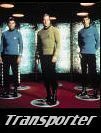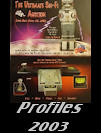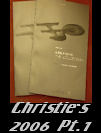It has been over 42 years since the first TOS props were created for use on the Desilu soundstage, and much controversy exists today about the total number of pieces fabricated and even the sources used to create the different Phaser, Tricorder and Communicator hand props employed on the series. Unfortunately, the historical record on many of these issues is simply incomplete; with large gaps in the known paper trail; and as many of the Original Series production crew who possessed first hand knowledge have now passed away – some questions seem destined to remain unresolved.
What follows are some insights on TOS prop construction activity gleaned from the published writings of some of Star Trek’s creators and some well respected experts in the area. In particular, a very enlightening account is contained in the 1996 book “Inside Star Trek – The Real Story”, written by Herbert Solow and Robert Justman, who were the Executive In Charge of Production for Desilu and the Associate Producer (later Co-Producer) of Star Trek, respectively. The complete account, contained on pages 118 through 120 of the book, is also reproduced in full in the document scans at the bottom of this post; and is worthy of reading.
Justman and Solow reaffirm the well established fact that Original Series props were fabricated by both the internal Desilu Prop Shop personnel as well as the prop manufacturing shop Project Unlimited where the celebrated artist Wah Chang was based. It is known that standard industry practice (then and now) required the fabrication of what is called “hero” or working props appropriate for high resolution close-up photography as well as the fabrication of much less perfect “stunt” or dummy pieces that would only be seen on camera in the distant background and were best suited for situations where they might be tossed about as part of an action sequence. These non-hero props were certainly never intended to appear at high resolution on camera and thus were often sloppily created with visible glue stains and/or smeared paint jobs and untidy construction details … some photos of typical TOS stunt pieces as auctioned from the Dwyer collection and from other reputable sources are also included in this post. Despite the production crews best intentions; however, over the course of 3 seasons of filming, some of the stunt pieces did inevitably manage to get captured onscreen at sufficiently close range where their imperfect nature is apparent.
It is known that both the Star Trek Communicators and the Phasers were actually produced at three different levels of detail – working versions (“heroes”) that featured some degree of moving parts or functioning lights; a mid-grade level which was non-working but fairly well crafted; and a fragile thin plastic stunt-version with messy, incomplete detail generally meant to be photographed only from a great distance on-screen . There were “hero” versions of Tricorders as well, created by Wah Chang, which were used for close-up photography (such as the view of the newspaper images projected on the Tricorder display screen in “The City on the Edge of Forever”) but these pieces did not have any functioning lights or built-in visual special effects such as rotating moirés that were incorporated into the other TOS hero versions. The Type II phaser pistol “hero”, as documented in a different article on this site, featured a working grain-of-wheat light bulb at the base of its acrylic beam emitter and a fully rotating silver thumbwheel on the top surface of the Hand Phaser that would raise and lower an acrylic “sight” mechanism as well as activate the emitter light bulb. Additionally, turning this thumbwheel would slightly extend/retract the acrylic beam emitter itself away from or slightly into the main body of the phaser. And the working communicator, ofcourse, is well known to have had an embedded stopwatch mechanism between its black plastic (kydex) shells which would power the spinning moiré effect that was filmed most effectively in the TOS episode “Friday’s Child”.
A closeup of the Hero Type II Phaser pistol:
A stunt phaser pistol from a Profiles In History auction that was accompanied by 1960’s era provenance from William Shatner:
Although the above prop has impeccable provenance; I suspect that its messy appearance prevented it from ever appearing at close range on-film – such that a viewer examining a TOS screenshot could make out sufficient detail to uniquely identify this truly authentic piece.
A hero hand phaser (actually the removable Type I unit from one of the complete hero pistols):
Some midgrade hand phasers from TOS Set Decorator John Dwyer’s collection:
Some stunt hand phasers, also from the Dwyer collection:
A hero communicator, as seen in “Friday’s Child”:
A midgrade non-working communicator:
Some fragile stunt communicators as seen in the episode “I, Mudd” in the hand of a female android:
The author believes that the preceding 2 photos could be capturing 2 different stunt pieces, since the top communicator possess a heavy application of gold paint or foil present on its top shell spanning the distance between the 2 simulated brass wheels; while the bottom photo does not have this solid gold application and also has a slightly different looking antenna grille from the first piece (with grille holes that extend completely on the right side to the cylindrical support rod). The fan site HeroComm adamantly asserts that only 10 communicators were ever produced for TOS; all constructed by Wah Chang, and that there has never been any photo evidence ever produced that “even remotely suggests others being made”. This reckless assertion is easily disproved by the above episode screenshots showing the stunt pieces created by the internal Desilu Prop shop.
Some pictures of a hero Wah Chang fabricated-Tricorder:
Some midgrade Tricorders produced by the internal Desilu prop shop:
A Desilu stunt Tricorder with unstitched strap, untidy drawer assembly and resin versus metal disc & moiré bezel components:
Here are some photos showing the internal construction of the Greg Jein “hero” phaser:
And the inside of a “hero” communicator (although, it should be noted, that there is not a uniform consensus of expert opinion on the authenticity of this prop):
Portions of 6 phaser props are seen together in the shuttlecraft phaser locker in the episode “The Galileo Seven”:
(Note, when looking at the top right photo, at the shadows cast by the acrylic beam emitters, how the 3rd shadow shows an extremely short emitter. This is likely the slightly recessed emitter from a working phaser that was mixed in with some midgrade props. The working piece is also removed from the locker in the bottom right photo.)
In further discussion on Wah’s contributions to TOS, Justman describes at length how the union strenuously objected to the use of Mr. Chang’s services on the series and how a claim that the Star Trek office was purchasing independently created “ready-made” props from Wah Chang proved to be a way to circumvent union-created obstacles and acquire Wah’s pieces prior to the filming of the first season. Justman notes that “A year later, prior to our second season, the same union problem erupted all over again. So we continued to buy ‘ready-made’ props from non union member Wah Chang.” Only a few receipts have been published in different Star Trek reference works (notably, “Inside Star Trek” and “The Star Trek Sketchbook” ) that document Wah’s prop sales associated with 1st Season production ONLY. Even though Justman and Solow state in the excerpt above that Wah Chang provided more props in subsequent seasons, the historical record is lacking and complete details for what was provided are not fully known.
Here are some of the 1st season sales receipts from Wah Chang …
Two hero Tricorders at $275 each:
Ten communicators for $1019.20 :
A receipt for Romulan helmets and ears:
A receipt for Phaser rework activity:
At $275 per prop (the cost Wah Chang charged for one Tricorder, the most complex hand prop to fabricate), $7000 would have purchased 25 Tricorders. At $102 per prop (the average cost Wah Chang charged for one Communicator), $7000 would have purchased 68 Communicators. At $189 per prop (averaging the Tricorder & Communicator unit prices), $7000 would have purchased 37 assorted hand props.
Certainly, the large gaps in the TOS prop production historical record (such as the lack of a list of the $7,000 Desilu “abortions” and the lack a list of Wah’s complete post-first season hand prop deliveries mentioned by Justman) , as well as the spread of misinformation by poorly-researched fan sites like HeroComm (who claim those Desilu built stunt communicators seen in the “I, Mudd” screenshot never existed); all serve to complicate the authentication process of Original Series pieces.
Additionally, one must consider in evaluating authenticity that some TOS props have undergone restoration/repair activities over their lifetime … Greg Jein is known to have repainted some hand props in his collection and refurbished communicator jewels/knobs on his original pieces, and Wah Chang is known to have repainted some original hand phasers from black to grey body color. A knowledgeable collector should be careful not to immediately reject the authenticity of a TOS prop due to a seemingly incorrect paint scheme. Also, it is known that during the filming of the Original Series, hand props were routinely damaged as a result of rough handling on the soundstage and then underwent repair operations to restore their appearance. An original TOS communicator in the authors collections shows evidence of being opened and resealed on multiple occasions with different color layers of glue visible – sometimes sloppily applied. And leatherette strips are known to have been affixed to some Tricorder surfaces as part of repair operations in the studio. The well respected propmaker Richard Coyle, who created hand props for the Star Trek feature films, in the RACprops Issue 5 Classic Communicator Update article on his website http://www.racprops.com/ ; mentions some hand-drilled 3rd season antenna grilles being fabricated for TOS that were supposedly very rough. Below is a screenshot from the 2nd season episode Friday’s Child which clearly shows a communicator antenna with individually drilled grille-holes … as opposed to the pre-punched, perfectly aligned holes also seen on authentic TOS communicators …
As well, it should be recognized that the vast majority of authentic, screen-used Original Series props and costumes in existence have been in circulation in private collections for over 40 years and will not possess any studio paperwork attesting to their origin. Only a few, rare pieces will be accompanied by letters from the likes of a Matt Jefferies or a John Dwyer and will have the impeccable provenance of being continuously owned since the ‘60s by these former Desilu employees. Such pieces would obviously command a great premium at auction.
Here is the “Inside Star Trek” commentary in its entirety…






















































































































